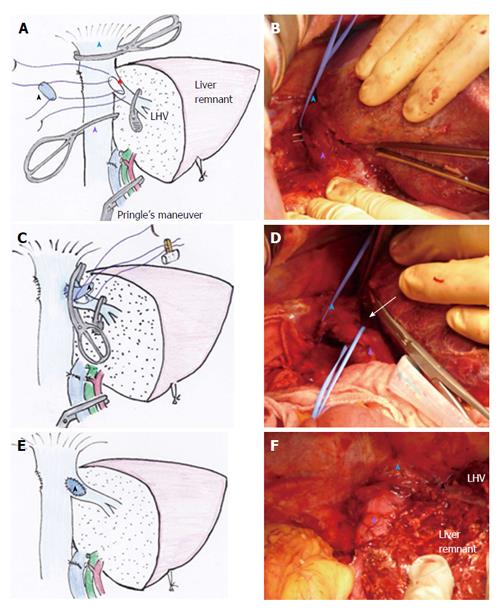Copyright
©The Author(s) 2016.
World J Hepatol. Mar 18, 2016; 8(8): 411-420
Published online Mar 18, 2016. doi: 10.4254/wjh.v8.i8.411
Published online Mar 18, 2016. doi: 10.4254/wjh.v8.i8.411
Figure 3 Switching the cross-clamp, performed in case 3.
A (illustration) and B (intraoperative image): The right liver and involved right wall of the LHV and a part of the IVC wall had been resected en-bloc under standard THVE (red star indicates the orifice of resected IVC and LHV), before which the suprahepatic IVC was taped (blue arrowhead, blue tape), and the caudal cross-clamp was placed just under the confluence of LHV to the retrocaval space that had been already dissected (B). The defect of the confluence of the IVC and LHV was to be reconstructed by using an IMV patch graft (black arrowhead); C (illustration) and D (intraoperative image): After suturing the IMV patch graft to the IVC part of the defect, the IVC cross-clamps were removed and the clamp was switched to the confluence of the LHV to restore the systemic circulation via the IVC. The space for switching the clamp was spread by the caudal blue tape (white arrow in D); E (illustration) and F (intraoperative image): The view after reconstruction is shown. See Figure 1C for tumor status. IMV: Inferior mesenteric vein; IVC: Inferior vena cava; LHV: Left hepatic vein; THVE: Total hepatic vascular exclusion.
- Citation: Ko S, Kirihataya Y, Matsumoto Y, Takagi T, Matsusaka M, Mukogawa T, Ishikawa H, Watanabe A. Retrocaval liver lifting maneuver and modifications of total hepatic vascular exclusion for liver tumor resection. World J Hepatol 2016; 8(8): 411-420
- URL: https://www.wjgnet.com/1948-5182/full/v8/i8/411.htm
- DOI: https://dx.doi.org/10.4254/wjh.v8.i8.411









